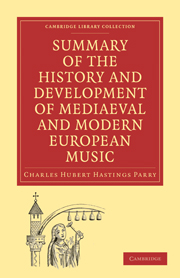Book contents
- Frontmatter
- PREFACE
- Contents
- CHAPTER I THE MUSIC OF THE MIDDLE AGES
- CHAPTER II MUSIC IN ENGLAND FROM THE BEGINNING OF TUDOR TIMES TILL THE RESTORATION OF THE STUARTS
- CHAPTER III THE BEGINNINGS OF OPERA AND ORATORIO
- CHAPTER IV THE PROGRESS OF OPERA IN VARIOUS COUNTRIES, FROM THE MIDDLE OF THE SEVENTEENTH CENTURY TILL THE TIME OF GLUCK
- CHAPTER V ORATORIO IN THE TIME OF BACH AND HANDEL
- CHAPTER VI THE PROGRESS OF INSTRUMENTAL MUSIC UP TO THE TIME OF J. S. BACH
- CHAPTER VII THE PROGRESS OF INSTRUMENTAL MUSIC IN THE EIGHTEENTH CENTURY
- CHAPTER VIII OPERA IN GLUCK AND MOZART'S TIME, AND IMMEDIATELY AFTER
- CHAPTER IX THE PROGRESS OF INSTRUMENTAL MUSIC TO BEETHOVEN AND HIS IMMEDIATE SUCCESSORS
- CHAPTER X MODERN INSTRUMENTAL MUSIC
- CHAPTER XI MODERN OPERA
- CHAPTER XII MODERN VOCAL MUSIC
CHAPTER I - THE MUSIC OF THE MIDDLE AGES
Published online by Cambridge University Press: 29 August 2010
- Frontmatter
- PREFACE
- Contents
- CHAPTER I THE MUSIC OF THE MIDDLE AGES
- CHAPTER II MUSIC IN ENGLAND FROM THE BEGINNING OF TUDOR TIMES TILL THE RESTORATION OF THE STUARTS
- CHAPTER III THE BEGINNINGS OF OPERA AND ORATORIO
- CHAPTER IV THE PROGRESS OF OPERA IN VARIOUS COUNTRIES, FROM THE MIDDLE OF THE SEVENTEENTH CENTURY TILL THE TIME OF GLUCK
- CHAPTER V ORATORIO IN THE TIME OF BACH AND HANDEL
- CHAPTER VI THE PROGRESS OF INSTRUMENTAL MUSIC UP TO THE TIME OF J. S. BACH
- CHAPTER VII THE PROGRESS OF INSTRUMENTAL MUSIC IN THE EIGHTEENTH CENTURY
- CHAPTER VIII OPERA IN GLUCK AND MOZART'S TIME, AND IMMEDIATELY AFTER
- CHAPTER IX THE PROGRESS OF INSTRUMENTAL MUSIC TO BEETHOVEN AND HIS IMMEDIATE SUCCESSORS
- CHAPTER X MODERN INSTRUMENTAL MUSIC
- CHAPTER XI MODERN OPERA
- CHAPTER XII MODERN VOCAL MUSIC
Summary
During the centuries in which the Roman Empire was falling to pieces, and until some of the modern states began to emerge from the chaos of barbarism and bloodshed, the development of any art was impossible. Music was only cultivated by Churchmen and was of the simplest description—confined to melody only, and indefinite in pitch and rhythm.
A certain number of scales or modes, and a few simple traditional formulas of melody, were authorised for Church use about the fourth century; and a few more modes, which were really only extensions of the earlier ones, were added some centuries later. The modes of the earlier group are always associated with the name of Ambrose, Bishop of Milan, who died 397 a.d., and are called Authentic; the later ones are associated with the name of a Pope Gregory and are called Plagal Modes. Gregory also supplemented the earlier collection of tunes by some fresh ones, and from that time forward these Church tunes were known as Cantus Planus, or Plain Chant.
The methods of writing music were extremely scanty and imperfect. The sources of the modern system of writing were the Neumes, which were marks put over the words to be sung, and indicated vaguely the inflections or changes of pitch to be used. They were made more definite as time went on by drawing coloured lines through the haphazard open order of the Neumes, which were thereby made to indicate definite relations of pitch and definite intervals; and the shapes of some of the Neumes, through which the lines were drawn, gradually changed into some of the notes which are used in modern times.
- Type
- Chapter
- Information
- Publisher: Cambridge University PressPrint publication year: 2009First published in: 1893



